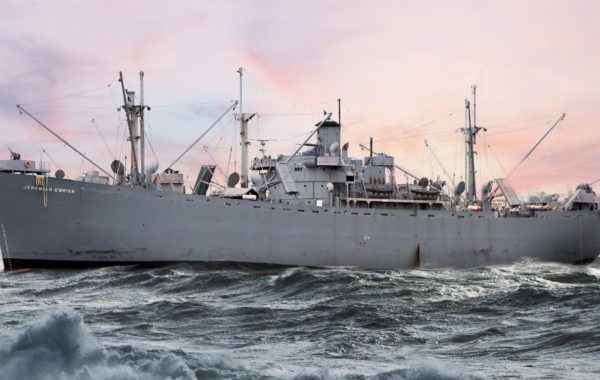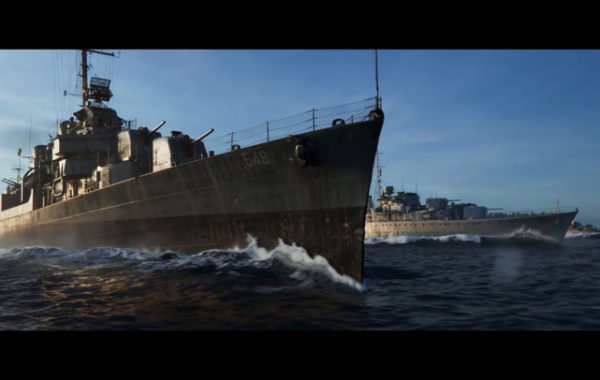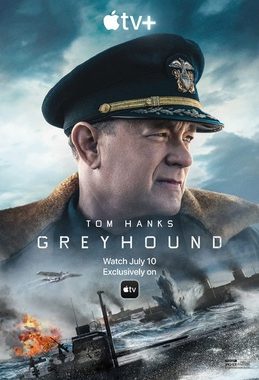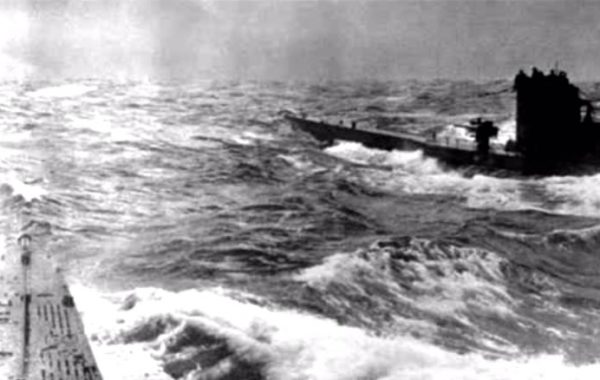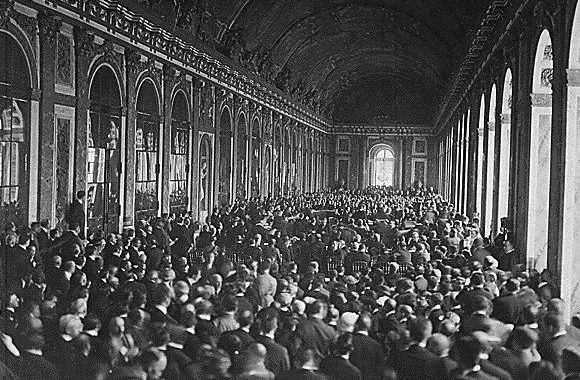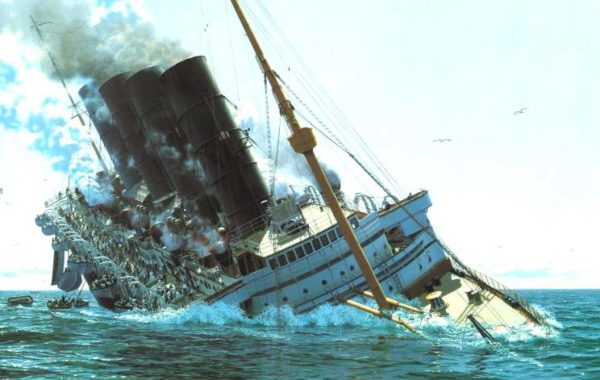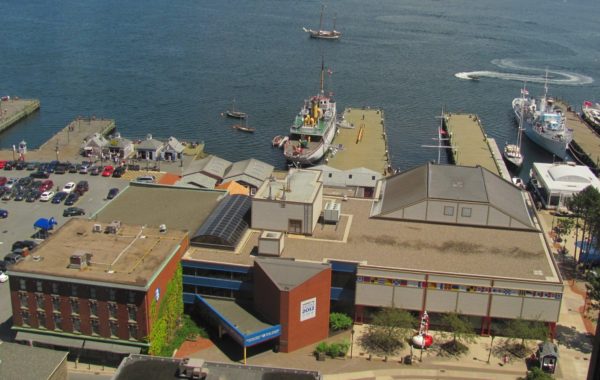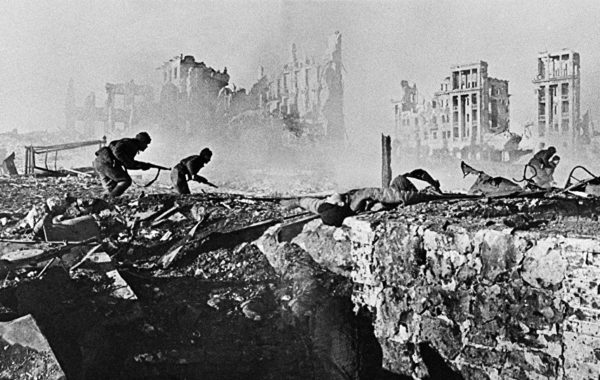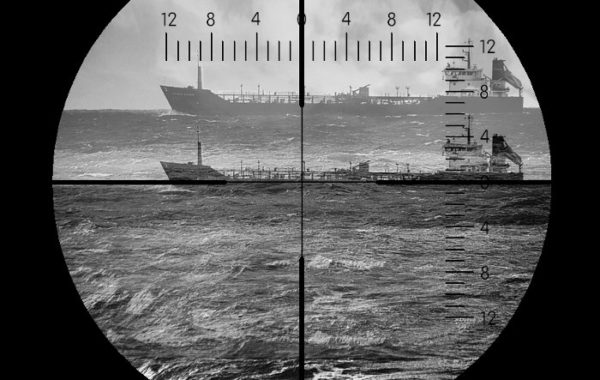A decade and a half after the Great War, the United States anxiously watched as tensions between European nations steadily mounted. War was coming again, and America needed to expand and modernize its merchant fleet in order to be prepared. The country’s fleet of freighters was aging and growing obsolete. The fleet needed more tankers and dry cargo ships.
To meet that need, Congress passed and President Roosevelt signed into law the Merchant Marine Act of 1936. The U.S. Maritime Commission, a creation of the act, laid the groundwork for expansion of the merchant fleet. By 1939, U.S. shipyards were turning out 50 ships a year. After Germany marched into Czechoslovakia, and the Maritime Commission doubled the building pace to 100 merchant ships a year, and then doubled the target again to 200 per year.
A year later, the British ordered 60 freighters from American shipyards to replace its merchant ships being sunk by German U-boats as the Battle of the Atlantic roared to life. The British design was based on the venerable tramp steamer, with its simple and reliable steam-engine power plant. It was cheap to build and cheap to run because the British had an abundance of coal for making steam.
American shipbuilders, stimulated by the British order, created a cargo vessel that was even quicker and easier to build. The construction process saved money and time by welding together the hull’s steel plates instead of riveting them. The American ship made use of the old triple-expansion steam engine because it was more rugged, easier to service, and more simple to build than a steam-turbine engine. Because of the ship’s standardized design, its parts could be widely manufactured.
The major emphasis for U.S. shipyards had become quantity: to build as many reliable ships as possible and as quickly as possible. In February, 1941, President Roosevelt announced a new U.S. shipbuilding program that would make use of mass production techniques. But, he warned, these new cargo ships would be “dreadful looking objects.”
In September, 1941, some 230 days after her keel was laid, the S.S. Patrick Henry was launched. She was the first of 2,700 U.S.-built cargo vessels known as “Liberty Ships,” and they would play a key role in the Battle of the Atlantic.
Thomas C. Sanger
Battle of the Atlantic, Part 2
“Greyhound,” the new World War II movie starring Tom Hanks, depicts a U.S. Navy destroyer’s harrowing effort to protect a convoy of ships crossing the Atlantic Ocean from North America to the British Isles. The voyage takes place in early 1942, shortly after the United States entered the war, and at a time when German U-boats held the upper hand in the Battle of the Atlantic.
Convoys were an attempt to counter the ever-present U-boat threat to Allied merchant shipping. The threat was greatest in the mid-Atlantic “black pit,” roughly 50,000 square miles that could not be protected because of the limited range of Allied land-based aircraft.
The convoy – a grouping of merchant ships in a disciplined formation protected by a squadron of warships – was successfully employed late in World War I. Initially, merchant sea captains had been reluctant to sail in tight formations, fearful of collisions in the foggy, storm-tossed North Atlantic. Convoys, they said, would present attractive targets for U-boats, and could sail only as fast as the slowest ship, thus prolonging exposure to attack.
But as U-boats sank an increasing number of merchant ships sailing alone in World War I, the wisdom of the convoy system became apparent. While it took three years of naval warfare before Britain instituted convoys in World War I, it took the British Admiralty less than a week following Athenia’s sinking to establish the convoy system in World War II.
A convoy might consist of from 45 to 60 merchant ships, arranged in nine to twelve columns, each ship maintaining 900 yards from the ship in front of it. Each of the columns was separated by 1,000 yards. The formations could be up to four miles wide and two miles long, with the most vulnerable ships – troop carriers and tankers – in the center. A convoy was protected by ten or more escort warships, depending on availability and convoy size. As depicted in “Greyhound,” these escorts were mostly small, fast and maneuverable: typically destroyers and corvettes, the latter being a smaller, British-designed ship tailored for escort duty.
The German tactic of the “wolf pack,” a gathering of up to a dozen or more U-boats, was developed to conduct coordinated attacks on convoy formations. Wolf packs proved effective through the first half of the war, but as “Greyhound” makes clear, these sea battles always carried some risks for U-boat captains.
By mid-1943, Allied advances in detecting, locating, and attacking U-boats turned the tide in the Battle of the Atlantic. In May of that year, U-boats sank 34 merchant ships, but at a cost of 34 U-boats, a one-to-one ratio that Germany could not sustain.
Although sporadic attacks on convoys would continue through the final two years of the war, the German navy’s U-boat commander, Admiral Karl Doenitz, acknowledged Germany had lost the Battle of the Atlantic that summer of 1943.
Battle of the Atlantic, Part 1
The new Tom Hanks movie, “Greyhound,” shines a light on one of the most consequential, yet largely overlooked conflicts of World War II – the Battle of the Atlantic. It was by far the longest continuous combat action of the war, beginning on Sept. 3, 1939, and ending May 8, 1945, the same day Germany surrendered.
Scholars have called the early months of WWII the “Phony War.” England and France had pledged to defend Poland, but took no action when Germany attacked and defeated the Poles in September, 1939. Although the British and French declared war on Germany September 3, both sides avoided major combat actions on the ground or in the air for the eight months following the fall of Poland.
But there was nothing phony about the war being waged in the Atlantic Ocean during that same period. Readers of this blog know the first shot fired in the Battle of the Atlantic was the torpedo that struck the British passenger ship Athenia less than nine hours after Britain and Germany declared war.
The battle was fought over shipping tonnage. Following the fall of France in June, 1940, the British were left to fight on alone against the Nazis. An island nation, Great Britain required a million tons of food and supplies every week in order to sustain its citizens and its war effort. German naval and air forces set out to interrupt that flow of supplies, and by the end of September they had sunk nearly 40 British merchant ships.
Clearly, such losses would be unsustainable over any length of time. For this reason, British Prime Minister Winston Churchill, writing later in his history of the war, said the only thing that frightened him during the war was “the U-boat peril.”
In coming months we will explore more about the Battle of the Atlantic, from the convoy system to U-boat wolfpacks, and the back-and-forth evolution of technology and tactics as both sides sought advantage on this expansive “battleground.”.
A Brief History of Submarines, Part 7
After experiencing poor results early in the war, Karl Doenitz, the German U-boat fleet commander, reintroduced his “pack tactic” in the summer of 1940. It called for multiple U-boats to attack a convoy at the same time, a gathering that became known as a “wolf pack.”
The approach was simple in theory. The first U-boat to detect a convoy would alert others and shadow the formation until more U-boats could assemble for the attack. Early in the war, coordination of the attack was given to the senior U-boat commander on the scene. But this proved cumbersome and the results were disappointing.
Doenitz’s revised approach was to have his headquarters coordinate the attacks. Once a shadow boat notified headquarters of a convoy’s direction and speed, the information was relayed to the nearest U-boats. When the pack assembled (each boat reporting as it arrived on station), headquarters alerted the captains of the number of boats in the pack and give the order to attack. U-boat commanders were on their own to attack as they saw fit. The sudden free-for-all was meant to overwhelm Convoy escorts.
The success of the wolf pack was immediately apparent. From June to October 1940, U-boats sank 274 merchant ships for a total of nearly 1.4 million tons of shipping capacity. At the same time, only six U-boats were lost. The number of merchant ships sunk exceeded available replacements, a situation that, if sustained by Germany, would cut the British Isles’ lifeline. Not surprisingly, the period came to be known as “the happy time” for the U-boat fleet.
To achieve its ultimate goal, the wolf pack tactic required construction of many more U-boats and relied on the coded messaging between fleet headquarters and boats at sea provided by the supposedly unbreakable Enigma encryption device.
To answer the first need, U-boat construction was ramping up. By the end of 1941, Doenitz would have 91 operational U-boats. That year, they managed to sink 432 ships amounting to more than two million tons of capacity lost. The number of available U-boats would more than double in 1942, but the tonnage of ships sunk did not keep pace.
The ratio of merchant shipping losses did not continue to grow as the number of U-boats increased, because of several factors. The supposedly unbreakable Enigma device was compromised in mid-1941. British intelligence operatives received a huge boost in breaking the code when the Royal Navy captured an Enigma machine and vital code books from a sinking U-boat. (See blog “Enigma’s Mysteries Revealed,” Oct. 2, 2018.) At the same time, British convoy escorts were devising new, more effective counter measures to deal with wolf packs. And in December of 1941 the United States entered the war following the Japanese attack on Pearl Harbor.
We’ll have more about these developments in our next blog.
A Brief History of Submarines, Part 4
Following the armistice in November, 1918, that ended World War I, the victorious powers – England, France, America, Italy, and Japan – met in Paris beginning in January, 1919, to determine the fate of the losers. The Treaty of Versailles, signed in June, saddled Germany with crippling reparations, loss of territory, and stifling limitations on its military forces.
One of the treaty’s more contested negotiations involved the fate of submarines. The U-boat tactic of unrestricted warfare against merchant shipping led some delegates to call for a ban on all submarines as weapons of war. This drastic step was eventually deemed unnecessary because future submarine tactics could be limited through restrictive naval treaties.
The issue was academic for Germany, which was prohibited from having any submarines by the Versailles Treaty. It also required Germany to surrender all its U-boats, including those under construction, thus giving the allied navies a valuable insight into German submarine technology.
In subsequent years, the treaty’s harsh conditions created sympathy within some allied nations for the hardships it imposed on the German people, particularly as the Great Depression struck Europe in the early 1930s. Consequently, many turned a blind eye as Germany began to build up its military forces. Beginning in 1933, under the newly elected Nazi regime, Germany openly began building a few new U-boats in violation of the treaty, launching the first of these new boats in April, 1935. They were nearly identical to one of the most successful U-boat designs from World War I, a stark example of how 15 years of prohibited submarine operations had stunted German U-boat design and technology.
Unwilling to challenge Germany over its violation of the Versailles Treaty’s restrictions, England entered into a new Anglo-German Pact in 1935, in which Germany agreed to limit the size of its navy to 35 percent of the overall size of the Royal Navy fleet.
To address any lingering concerns about unrestricted warfare tactics by submarines, England, Germany and 33 other nations signed the London Submarine Protocol of 1936. The protocol affirmed earlier restrictions that a submarine could not attack an unarmed, unescorted merchant ship without first giving warning of its intent. This required a submarine to surface and put a boarding party on the merchant ship to inspect its cargo for contraband. If any such cargo was found that could aid an enemy’s war effort, the ship could be sunk, but not before its crew was removed to a place of safety.
The British may have believed they had capped German rearmament and contained the most menacing of U-boat tactics, but a reckoning awaited them and the world three years hence. The submarine was soon to play an expanded role in naval warfare, as we will see in our next blog.
A Brief History of Submarines, Part 3
At the beginning of World War I in July, 1914, Germany had 48 submarines, or “U-boats” (for Unterseeboot), in service or under construction. The German boats would prove more reliable and more lethal during the course of the conflict. Indeed, a German U-boat, U-21, was the first to sink a warship with a self-propelled torpedo when she attacked H.M.S. Pathfinder, Sept. 5, 1914.
In the opening months of the war, submarines, like their surface ship counterparts, observed the traditional “prize rules” with regard to merchant shipping. That is, merchant ships were stopped and captured or they were sunk once their crews were taken off the ships. But on Oct. 20, 1914, U-17 torpedoed and sank the first merchant ship of the war, the British-flagged S.S. Glitra, without observing the prize rules.
By February of 1915, Germany’s Kaiser Wilhelm II declared the waters around the British Isles to be a “war Zone” in which any ship could be attacked without warning, setting the stage for one of the war’s most dramatic events. On May 7, 1915, U-20 sank R.M.S. Lusitania off the Irish coast, killing nearly 1,200 passengers and crew, including 128 Americans.
The shocking deaths of so many civilians stunned the world. The United States, at the time a neutral country in the war, threatened to sever all ties with Germany. The threat prompted Germany to reinstate the prize rules in full and order seemed to have been restored. U-boat tactics involved surfacing to surprise a merchant vessel, advising its crew to abandon ship, then using the U-boat’s deck gun to sink the ship. Torpedoes were expensive and less reliable than surface fire so they were used sparingly.
A year later, at the end of May, 1916, the German and British fleets clashed in the Battle of Jutland. Although Germany claimed victory, the Royal Navy remained firmly in control of the seas. As a result, German naval high command argued to abandon the prize rules and resume attacking merchant shipping. They gambled that a high rate of merchant shipping losses would force Britain to sue for peace before the U.S. could effectively enter the war.
By the end of January, 1917, Germany announced its U-boats would henceforth conduct unrestricted warfare against all shipping. In mid-March, Germany sank three American merchant ships. The U.S. declared war on Germany April 4. The German tactics were initially effective, but the introduction of the convoy system later in the year reduced the U-boats’ success rate and in the end, Germany failed to sink enough Allied shipping to gain victory or even a stalemate.
In the final counting, Germany built 373 U-boats during the war and lost 178 to Allied action. But U-boats sank more than 30 warships and 5,000 merchant and fishing vessels, killing 15,000 sailors and civilians. In the minds of many merchant seamen the submarine had become a weapon of terror, and many negotiators at Versailles pushed to outlaw the submarine altogether.
In our next blog we will look at how the submarine navigated the interwar period.
Athenia’s 80th Anniversary
At the start of World War II, the passenger ship Athenia was torpedoed by a German submarine and became the first British ship sunk by the Nazis in the war. While Athenia’s story has faded over the intervening decades, people intent on keeping her memory alive will assemble in Halifax, Nova Scotia, on Sept. 3, 2019, to commemorate the 80th anniversary of the sinking.
Athenia was bound for Canada with 1,418 souls aboard, when she was torpedoed by a German U-boat northwest of Ireland. One hundred twelve passengers and crew members died as a result of the attack that shocked the world on the first day of the war. By the end of the war, however, Athenia’s sinking had seemingly been lost in a tangle of Nazi denials and overrun by the scale of the war’s carnage.
Come Sept. 3, Athenia’s memory will be revived when nearly a dozen survivors and descendants of survivors meet in Halifax, the city that welcomed 236 passengers from the ship after they were picked up at sea by an American freighter 80 years ago.
The Maritime Museum of the Atlantic, located on the city’s historic waterfront, will host an evening program devoted to the Athenia. I am honored to be the featured speaker and hope to share the dais with survivors telling their stories of survival. The program is open to the public and will begin at 6:30 p.m. The museum will remain open until 8 p.m.
Eighty years ago, today’s remaining survivors were children traveling with their parents when Athenia sailed into harm’s way. With most now in their mid to late 80s, the gathering presents a rare opportunity to preserve their eye-witness accounts for our documentary film. Our film crew will be on hand for several days to conduct one-on-one interviews with the survivors and descendants about their families’ encounter with history.
Athenia should not be forgotten, nor should the sacrifice of the men, women, and children who died that night in the North Atlantic when their ship was torpedoed. Our documentary is dedicated to preserving their memory and Athenia’s place in history.
Athenia Story: A Compelling Documentary Subject
Two years ago I published my historical novel, Without Warning, about the British passenger ship Athenia, which was sunk on the first day of World War II. In writing a novel, I hoped its emotional impact would bring this long-forgotten event to the attention of a wide audience and honor the sacrifice and heroism of Athenia’s passengers. Sales to date total 391 books. Obviously, I am a long way from realizing my goal. The question is how to reach a wider audience more quickly?
I’m hoping the answer is a documentary film.
Earlier this year my wife, Kay, and I embarked on an effort to produce a documentary about Athenia. We hope to film interviews with as many survivors as we can locate.
We began last January by filming Geoff Etherington at his Florida home. Geoff was ten years old and traveling with his parents, Ruth and Harold, aboard Athenia when the ship was torpedoed. The Etherington family story is one of several dramatic tales from Without Warning that illustrate the strength and courage of the people aboard Athenia who suddenly found themselves thrust into a war they thought they had escaped.
We plan to film several more interviews with survivors or their descendants September 3, when we meet in Halifax, Nova Scotia, at the Maritime Museum of the Atlantic, to mark the 80th anniversary of the start of World War II and Athenia’s sinking.
Of course, we are on a steep learning curve with this project. A book is a fairly straight-forward endeavor. Once I researched and wrote the manuscript, I relied on a few key people to help edit, design, and see my novel into print.
By contrast, a film involves many more people. We must find and interview the survivors, descendants, and experts that can help tell Athenia’s story. To do that, we need the skills of cinematographers, sound recordists, actors (to recreate some scenes described by interviewees), a film editor, sound editor, composer (for incidental music), and a director to bring all these elements together in an artistic vision. Once that vision is realized, more people will be involved with the film’s distribution and promotion.
Each of these steps requires people who combine technical expertise with artistic sensitivity. Fortunately, we live in San Diego, which supports a thriving independent film community. Additional help, if needed, lies two hours to the north in Los Angeles, a nexus of the film industry.
Of course, this effort will require a significant budget to see our film through to completion. But if all goes well, we hope to have a compelling documentary film ready to distribute by early next year.
In the next few weeks we will make some changes to this website, adding a new page that will keep you up to date on our progress toward a completed documentary. And so, in those time-honored words we hear so often, I invite you to, “Stay truned.”
Why Don’t We Remember Athenia? Part 6
When German submarine torpedoed the British passenger ship Athenia on the first day of World War II, Sept. 3, 1939, the final death toll included 112 innocent men, women and children. The British immediately sought to condemn Germany’s Nazi government for this “barbarous act” by publicizing it around the world. Yet, at the end of the war nearly six years later, the world had largely forgotten this event.
In previous blogs we explored various reasons why Athenia faded into history’s shadows: the fact that 90 percent of Athenia’s passengers and crew survived the attack, that Germany denied responsibility for the attack until the Nuremberg trials in 1947, that the attack did not bring the U.S. into the war despite the deaths of 30 Americans, and that within months of the start of hostilities, Germany abandoned the treaties governing maritime conflicts and conducted unrestricted submarine warfare on merchant shipping for the duration of the war (followed by all other combatant nations).
One circumstance, however, likely bears the greatest responsibility for Athenia’s relative anonymity: the utter destruction wrought by World War II on humanity.
As the war progressed, people became inured to the casualty figures for individual battles: D-Day and the Battle of Normandy cost nearly 130,000 lives; the Battle of the Bulge, 187,000 lives; the Battle of Stalingrad, more than 1 million; and 112,000 killed instantly in Japan with the explosion of two atomic bombs. With the war’s end came the horrific revelation of the six million people killed in the Holocaust.
In terms of the total number of dead, the war was the most costly military conflict in history. The number of men and women in uniform who died during World War II is estimated at between 21 million and 25 million.
The number of civilian deaths, however, is estimated at between 50 million and 55 million, including deaths from war-related disease and famine.
Even taking the lower range of the military and civilian deaths, the total represented 3 percent of the world’s population, estimated at about 2.3 billion in 1940.
It is easy to see how these astounding casualty numbers overwhelm the deaths of 112 people on the first day of the war. Still, we can remember the Athenia dead as harbingers of the fate that awaited civilians around the world in the nearly six years of war that followed.
Why Don’t We Remember Athenia, Part 5
In recent blogs we explored reasons why the German submarine attack that sank the British passenger ship Athenia in the first day of World War II is largely forgotten today. The facts that more than 90 percent of the ship’s passengers and crew survived, that the Nazi government denied responsibility for the attack, and that the death of 30 Americans aboard Athenia did not bring the U.S. into the war, were all seen as contributing to this historical oversight. In today’s blog we continue our exploration with a look at the rules of war.
Press accounts of the Sept. 3, 1939, attack all expressed shock that it had come “without warning.” Today such a reference sounds quaint and naïve, but in 1939 the rules of war – agreed to under international treaties – required submarines to warn certain prospective victims of their intention to attack.
During World War I, German submarines, or U-boats, proved to be such a devastating weapon that following the war, there was talk of outlawing submarines altogether. Negotiators ultimately agreed submarines could be retained as weapons of war so long as conditions were placed on their use.
These conditions were established in 1930 and reinforced in the 1936 London Submarine Protocol, which set out rules for the conduct of submarines in future wars. Enemy warships and merchant ships sailing under escort could be attacked without restriction. But submarines could not attack unarmed, unescorted merchant ships without first giving warning, and to do that they had to be on the ocean’s surface. Once a submarine stopped a merchant ship, it could send a boarding party onto the ship, and if any contraband was found in the ship’s hold, the ship could be sunk.
Submarines are most vulnerable while they are surfaced, so the protocol’s requirements were totally impractical from a tactical standpoint. Nevertheless, 35 nations, including Germany, signed the 1936 London Submarine Protocol. For the three years following its adoption, however, there had not been a major maritime conflict to test its effectiveness.
When Athenia was sunk by a U-boat without any warning, the world feared Germany was returning to the practice of unrestricted submarine warfare that it followed in World War I.
The Nazi U-boat captain who sank Athenia told his superiors he thought he had attacked a British armed merchant cruiser, a legitimate wartime target. He only discovered his mistake after coming to the surface to observe the sinking ship. Indeed, he continued his war patrol and sank two more British merchant ships while scrupulously following the protocol rules.
But by the end of September 1939, Hitler issued several conditions under which his U-boats could ignore the protocol’s restrictions and attack merchant ships without warning. These conditions applied if merchant ships were blacked out, used their radios to report German naval positions, or were obviously armed.
The practical effect of the Führer’s order was to sanction unrestricted U-boat warfare. Within a month, U-boat attacks on merchant ships without giving warning became commonplace, which prompted all others to abandon the London protocol. Once the world’s navies adopted the tactics of unrestricted submarine warfare, the shock of Athenia having been sunk without warning quickly faded.
Next month: War’s utter devastation


